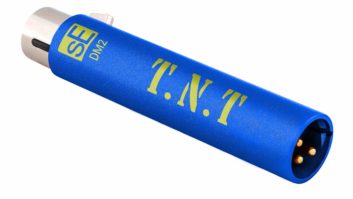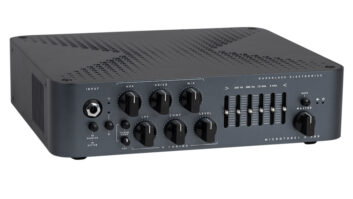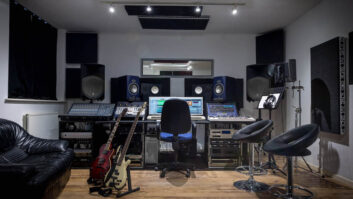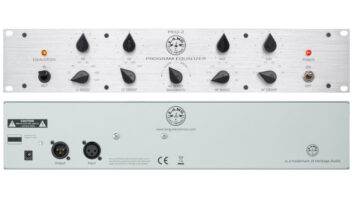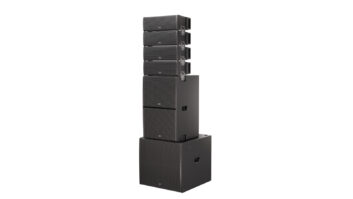
I have a friend, a self-proclaimed audio snob, who swears that if he ever heard a great-sounding Chinese microphone, it would be one of the signs of the Apocalypse. After reviewing three small-capsule mics from SE Electronics, I told him to cash out his 401k, buy the Ferrari and 100 gallons of ice cream, and wait for the flash.
As of this writing, SE Electronics, based in Shanghai, China, makes eight models of condenser microphones. The three mics tested for this review are all front-address, phantom-powered models with varying features, all from the same family of origin.
The SE1A ($199), an improvement on the company’s original SE1, is a solidly constructed, no-frills fixed-pattern condenser. It also comes as a factory-matched pair — including a stereo bar — in a wooden box for $449. Equivalent noise for this mic is 17 dB (A-weighted), the output impedance is 300 ohms and it will take up to 137dB SPL at 1k (0.5% THD). The SE2 ($399) carries the same electronics and specs as the SE1A, but has a slightly different body and comes with a shock-mount and three screw-on capsules (cardioid, hypercardioid, omni).
The stand-out of the trio is the fixed-cardioid SE3 ($349). It is broader and heavier than the other two, has a unique capsule and electronics and, like the SE2, ships with a shock-mount. Other SE3 features include a switchable low-end roll-off (-10 dB per octave starting at 120 Hz), a -10dB pad, the ability to take 135 dB at 1k (0.5% THD), an output impedance of 200 ohms and the same noise spec as the SE1 and SE2.
IN SESSION
I started off using all three mics around a drum kit. Two of the SE1As, used with the stereo bar, were pressed into duty as room mics, while a pair of SE3s were used as a spaced pair of overheads. This combo was wonderful. The SE1A and SE2 were on the bright side — too bright for my tastes — but with a bit of judicious placement, they worked very well. For this reason, I tried the SE2 on hi-hat and wasn’t disappointed. It sounded bright, as expected, but worked well for the purpose, needing no EQ to bring up the shine of the hat on the left side of my mix. The only improvement I’d make to the stereo bar would be to add a spacer under one of the clips to help make an easier over/under array when using it in X/Y. The SE3s sounded gorgeous when used as overheads. The ping of the stick hitting the cymbal was up front without being overly bright, and the rest of the cymbals never sounded trashy. The stereo picture was balanced and the kit sounded like you were in the room.
Next, I heard the SE2 used on a less-than-inspiring acoustic guitar. This particular guitar had a dull top end that was flattered by the SE2’s boosted high end. In another session, the SE3 worked perfectly when used to record a different acoustic guitar. The flat nature rendered a nice top and was never boomy.
The SE3s worked very well on a Yamaha C3 piano. This particular piano is brand-new and, like most Yamahas, a bit on the bright side. The flatness of the SE3 tamed it without making it sound dull. When compared to a competitor’s more expensive fixed-cardioid condenser, the SE3 beat it hands-down. I heard the mics in this application a few times and was pleasantly surprised at how well it sat the piano down in the mix when heard with a full drum kit, bass and guitar.
While I prefer a ribbon mic on tenor saxophone, the SE3 worked quite well; however, the SE1A and SE2 were too bright for this application.
SO IS IT REALLY THE END OF THE WORLD?
While the SE1A and SE2 sounded good, the SE3 was an unexpected surprise. It sounded excellent on a variety of sources, imparting a lot of detail without being brash. Most importantly, almost everything I heard recorded with it sat nicely in the mix with minimal need for EQ.
The SE1A and SE2 have a lot of added top end, while the SE3 sounds relatively flat. I wouldn’t call any of the mics “warm,” but with the SE3, the words “balanced” and “accurate” come to mind. The SE3, in particular, is great at rendering transients.
All in all, no matter what I threw at them, the trio handled it well. For drums, these mics are a lot of fun to use. The SE1A and SE2 seemed to work better in the room because of their natural high-end bump, while the SE3s excelled as overheads. On piano, sax and acoustic guitar, these mics did their job admirably.
All three models reviewed ship in nice, red-lacquered wooden boxes with hard foam inserts. (A single SE1A comes in a card carton with foam insert.) The spring-clip shock-mount (offered with the SE2 and SE3), while basic, is sturdy and offers a decent amount of isolation from stand noise. If you want to try these out, SE offers a try-before-you-buy program. (See Website for details.) These mics, especially the SE3s, are perfect for anyone on a limited budget looking for a high-quality condenser priced well under $500.
Distributed by Sonic Distribution, 617/623-5581, www.sonic-distribution.com.
Kevin Becka is Mix’s technical editor.
